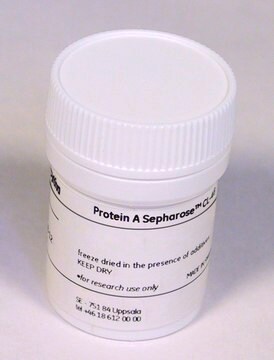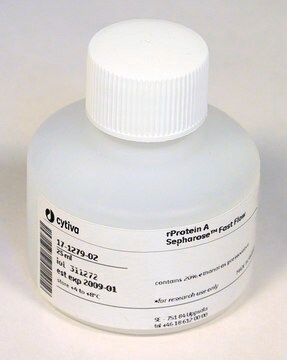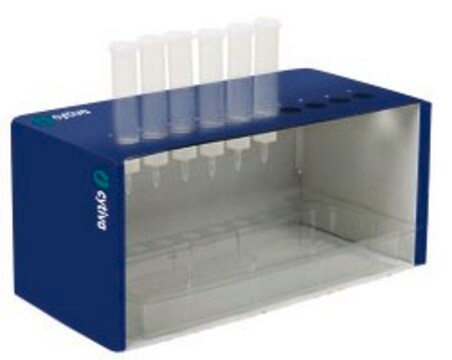GE17-0618-01
Protein G Sepharose™ 4 Fast Flow
Cytiva 17-0618-01, pack of 5 mL
Sinônimo(s):
Fast Flow resin, Antibody purification resin, IgG purification resin
About This Item
Produtos recomendados
ligand
recombinant protein G lacking albumin-binding region
embalagem
pack of 5 mL
fabricante/nome comercial
Cytiva 17-0618-01
condição de armazenamento
(20% Ehtanol)
Matriz
4% cross-linked agarose
diâmetro médio
90 μm (d50v)
cleaning in place
2-10
Faixa de trabalho
3-9
adequação
suitable for bioprocess medium
temperatura de armazenamento
2-8°C
Categorias relacionadas
Descrição geral
Protein G Sepharose™ 4 Fast Flow has recombinant protein G immobilized by the cyanogen bromide (CNBr) method to Sepharose™ 4 Fast Flow. Protein G exhibit binding specificities that complement Protein A media and binds to the Fc region of IgG from a variety of mammalian species. Protein G Sepharose™ 4 Fast Flow may be used to isolate and purify classes, subclasses and fragments of immunoglobulins from any biological fluid or cell culture medium.
As member of the BioProcess media range, Protein G Sepharose™ 4 Fast Flow meets industrial demands with security of supply and comprehensive technical and regulatory support.
Características e benefícios
- Binding specificities that complement Protein A media.
- Binds a broad range of IgG species and subclasses.
- Multi-point attachment minimizes ligand leakage.
- Used in a range of research applications.
Armazenamento e estabilidade
Nota de análise
Informações legais
produto relacionado
Palavra indicadora
Warning
Frases de perigo
Declarações de precaução
Código de classe de armazenamento
3 - Flammable liquids
Escolha uma das versões mais recentes:
Certificados de análise (COA)
It looks like we've run into a problem, but you can still download Certificates of Analysis from our Documentos section.
Se precisar de ajuda, entre em contato Atendimento ao cliente
Já possui este produto?
Encontre a documentação dos produtos que você adquiriu recentemente na biblioteca de documentos.
Os clientes também visualizaram
Artigos
This page shows a comparison of the relative binding strengths of protein G and protein A to different immunoglobulins.
This page describes immunoprecipitation (immunoaffinity or pull-down techniques).
This page describes efficient column packing and preparation for affinity chromatography of antibodies.
This page shows how to perform sample desalting and buffer exchange for affinity chromatography of antibodies.
Protocolos
This page provides information about different pull-down assays for the further isolation of multiprotein complexes to identify their components with products from GE Healthcare.
This page shows how to separate IgG antibodies by affinity chromatography using Protein G Sepharose 4 Fast Flow from GE Healthcare.
This page shows how to separate IgG antibodies by affinity chromatography using Protein G Sepharose 4 Fast Flow from GE Healthcare.
This page shows how to prepare samples for purification with affinity chromatography.
Conteúdo relacionado
Pull-down assays, reagents, and protocols for investigating in vitro protein-protein interactions using affinity or GST pull-down, tandem affinity purification (TAP), and co-immunoprecipitation methods.
Nossa equipe de cientistas tem experiência em todas as áreas de pesquisa, incluindo Life Sciences, ciência de materiais, síntese química, cromatografia, química analítica e muitas outras.
Entre em contato com a assistência técnica









